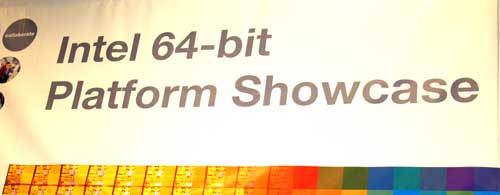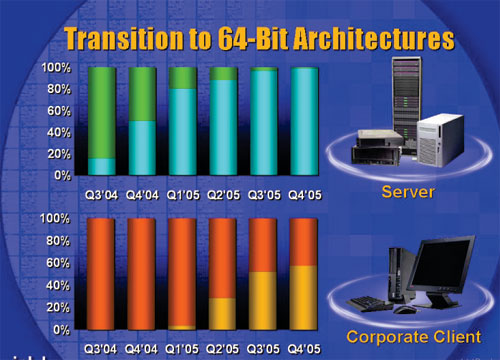IDF Spring 2005 Day 1 - Gelsinger Speaks, nForce4 Intel and more
by Anand Lal Shimpi & Derek Wilson on March 2, 2005 3:00 AM EST- Posted in
- Trade Shows
Intel and Microsoft on 64-bit - “It’s Time”
In the biggest slap AMD’s face has received in quite a while, Pat Gelsinger devoted a good bit of voice time to Intel’s move to 64-bit from the “data center to the desktop.” It sounded a lot like AMD’s spiel about x86-64 from a couple of years ago, but this time it was Intel saying it and commanding that it happen.

The chart below shows Intel’s aggressive ramping strategy for bringing EMT64 to desktops and servers.

The percentage market penetration that Intel is talking about here is nothing AMD could ever have dreamed of in their early days of AMD64. Yet, as everyone predicted long ago, Intel let AMD do all of the dirty work of getting people interested in why 64-bit was necessary, then swooped right in at the end to reap the benefits and do so bigger, and faster than AMD. Pat spent basically no time explaining why 64-bit was important, and all of the time explaining how quickly Intel was going to implement it and how the time was now.
Microsoft’s Jim Allchin came on stage and echoed Gelsinger’s statements with the simple line “it’s time.” Other than the mobile platforms, there wasn’t a single platform on display at IDF that wasn’t 64-bit enabled - a huge change from the way things used to be.
When AMD first started talking about 64-bit on the desktop Intel said that it wouldn’t be needed on the desktop for another 3 years, looks like they were right.
Microsoft will be shipping final versions of Windows Server 2003 x64 Edition and Windows XP Professional x64 Edition sometime next month. This slide below talks about some of the performance gains they’ve seen internally due to 64-bit support (thanks to the added registers and greater memory addressability):











19 Comments
View All Comments
mickyb - Wednesday, March 2, 2005 - link
Doesn't Intel's GOAT (Eh hmm IOAT) sound a lot like what nVidia was doing with their I/O chips? Intel should put "Not to scale" or "No real data was found" on every single one of those extrapolation graphs. I find it kind of funny how multi-core is the panacea to all performance problems. How is this any different than multi CPU SMP? It isn't, except for compressing them to a smaller space. SMP has its problems as well and the number of CPUs does not create an exponential graph like Intel is implying.I am interrested in this FBDIMM and will need to do some checking around on that one. It looks interesting. RAMBUS is still at it. We'll see how things shape up.
glennpratt - Wednesday, March 2, 2005 - link
That changes his point very little. And, YOU probably won't be buying crap out of pocket...Questar - Wednesday, March 2, 2005 - link
When will you guys realize how small the gaming market is?I'll buy more corporate systems this year than every gamer on this site will buy in the next five years.
Pete84 - Wednesday, March 2, 2005 - link
^^ Not just games, but every app too . . .ZobarStyl - Wednesday, March 2, 2005 - link
I love the graph on page 4, where multicore just jumps ahead by leaps and bounds, with the "Performance" being exponential growth. I'm sorry but the last time we saw something like this it was the NetBurst graph taking us into "10 GHz Space" and lo and behold, well you know the story. I'm so tired of Intel just putting a band-aid on a bad idea for a chip (not a bad chip mind you, just designed by marketing people, not engineers). Multicore without onboard memory controllers, tacking on an extra meg of slower cache to Prescott...why are we not seeing samples of a new chip that aims to correct the problems of NetBurst rather than just adding more and more to Prescott like it really is going to change the fact? Until games get really multi-core oriented, this last generation of single-core products is going to be the best thing out there until probably late 06.raskren - Wednesday, March 2, 2005 - link
^^You^^Guess what, none of these are anywhere near store shelves so CTFD (calm the F down).
The Nforce4 board finally adds some appeal to the latest Pentium 4s. I'd say that i875/865 were the last two exciting chipsets. 9xx has fallen short on innovation.
Beenthere - Wednesday, March 2, 2005 - link
The SpinMeisters from Intel are realing blow smoke up the azzes of journalist, as usual. Only the gullible would belive the nonsense these folks peddle when they can't even deliver a P4 without a fire extinguisher. No one with a clue would touch any of Intel's current or short term products. Maybe by '07 Intel will have something worth considering but that remains to be seen.xsilver - Wednesday, March 2, 2005 - link
The idea of VT is a good one I think -- it may be possible to run a small office on only 1 multicore, multithread system? (spreadsheets and email aren't exactly taxing)and intel's idea of split dual cores may be future possibilities of selling cpu's scaled with cores rather than clock speeds?
eg. Extreme edition will have 8 cores, regular will have 4-7 cores ... celerons will have 1-3 cores... according to how the cpu's are binned?
bersl2 - Wednesday, March 2, 2005 - link
--quote--Microsoft’s Jim Allchin came on stage and echoed Gelsinger’s statements with the simple line “it’s time.”
--quote--
Duuuuuuuu... no, really?
"And Wintel said, 'Let there be light!' But they were too slow to realize that the light had been on for quite some time."